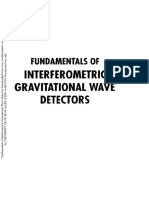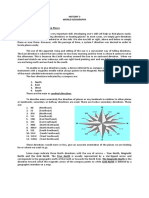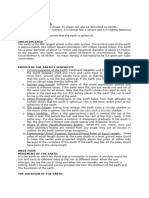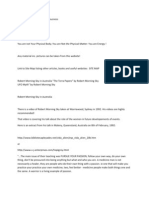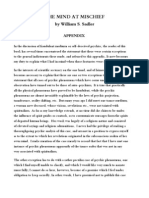0 ratings0% found this document useful (0 votes)
169 viewsDaily Motion Lab
Daily Motion Lab
Uploaded by
2e9818bdThis document contains observations of the night sky made over a period of 4-5 hours. A constellation in the southern sky (Corvus) was observed moving from south to west and lowering in the sky. The Big Dipper was seen moving in a circular pattern around Polaris. Polaris maintained the same position in the sky throughout observations. Based on these observations, the document concludes that the Earth rotates from west to east while Polaris remains fixed.
Copyright:
© All Rights Reserved
Available Formats
Download as PDF, TXT or read online from Scribd
Daily Motion Lab
Daily Motion Lab
Uploaded by
2e9818bd0 ratings0% found this document useful (0 votes)
169 views3 pagesThis document contains observations of the night sky made over a period of 4-5 hours. A constellation in the southern sky (Corvus) was observed moving from south to west and lowering in the sky. The Big Dipper was seen moving in a circular pattern around Polaris. Polaris maintained the same position in the sky throughout observations. Based on these observations, the document concludes that the Earth rotates from west to east while Polaris remains fixed.
Copyright
© © All Rights Reserved
Available Formats
PDF, TXT or read online from Scribd
Share this document
Did you find this document useful?
Is this content inappropriate?
This document contains observations of the night sky made over a period of 4-5 hours. A constellation in the southern sky (Corvus) was observed moving from south to west and lowering in the sky. The Big Dipper was seen moving in a circular pattern around Polaris. Polaris maintained the same position in the sky throughout observations. Based on these observations, the document concludes that the Earth rotates from west to east while Polaris remains fixed.
Copyright:
© All Rights Reserved
Available Formats
Download as PDF, TXT or read online from Scribd
Download as pdf or txt
0 ratings0% found this document useful (0 votes)
169 views3 pagesDaily Motion Lab
Daily Motion Lab
Uploaded by
2e9818bdThis document contains observations of the night sky made over a period of 4-5 hours. A constellation in the southern sky (Corvus) was observed moving from south to west and lowering in the sky. The Big Dipper was seen moving in a circular pattern around Polaris. Polaris maintained the same position in the sky throughout observations. Based on these observations, the document concludes that the Earth rotates from west to east while Polaris remains fixed.
Copyright:
© All Rights Reserved
Available Formats
Download as PDF, TXT or read online from Scribd
Download as pdf or txt
You are on page 1of 3
Daily Motion Lab
NAME: ___________________________Course Section: __________ DATE: ____________
On one night, shortly after sunset, find the Big Dipper (Ursa Major), the North Star
(Polaris) and a constellation in the southern sky such as ORION, PEGASUS or
SAGITTARIUS for example. NOTE!!! Stand in the exact same spot(s) each time you go
out to look. Mark it with a stick in the ground or a rock or a crack in the sidewalk.
1. Find a constellation in the south.) Note its position in the sky (e.g. SE, SSW, Azimuth
150, and Altitude 30). At hourly intervals, for the next 4 or 5 hours, repeat the
observations and record your findings below.
Constellation Name Position in sky (direction + degrees above horizon) Time
Corvus S Azimuth 182 , Alt 26 9 PM
Corvus SW Azimuth 200 , Alt 24 10 PM
Corvus SW Azimuth 213 , Alt 19 11 PM
Corvus SW Azimuth 226 , Alt 11 12 PM
Corvus SW Azimuth 237 , Alt 2 1 AM
2. Find the BIG DIPPER (Ursa Major). Note the time and sketch its position in the sky.
Record your observations below. At hourly intervals, for the next 4 or 5 hours, repeat the
observations.
Daily Motion Lab (page 2)
3. Find POLARIS. Note its position in the sky. At hourly intervals, for the next 4 or 5
hours, repeat the observations and record your findings below.
Position in sky (direction + degrees above horizon) Time
North - Azimuth 359, Alt 39 9 PM
North - Azimuth 359, Alt 39 10 PM
North - Azimuth 359, Alt 39 11 PM
North - Azimuth 0, Alt 39 12 PM
North - Azimuth 0, Alt 39 1 AM
4. What conclusions do you draw about the daily motion in each of the three cases?
Constellation in the southern half of the sky:
We were watching the constellation Corvus for 4-5 hours and after that we can say
that it kept moving from South to West at the same time it kept moving towards
the horizon. So we can say that the part of Southern sky is moving from East to
West which means the Earth is moving from West to East.
Big Dipper:
From our observations and plotting them on the given table we can say that Big
Dipper moved from North to East and kept moving in a circular pattern around the
Polaris.
Polaris:
The position of Polaris remained the same throughout our observation period.
Daily Motion Lab (page 3)
5. If you could see Polaris and these constellations in the sky 12 hours after you started
observing, how would you describe how they moved and where would they be in the sky?
Polaris would be at the same position but Big Dipper would be in the opposite
position where we observed 12 hours before. While Corvus would not be visible
after 12 hours as its azimuth and altitude keeps decreasing. Since we know that it
was going towards South West and to the horizon it would be on the other side of
the Earth from where we were standing.
You might also like
- ConstellationsDocument50 pagesConstellationsLawrence MatunogNo ratings yet
- Fundamentals of Gravtitaional Wave Interometric DetectorsDocument304 pagesFundamentals of Gravtitaional Wave Interometric DetectorsDanyel DayNo ratings yet
- Sample Physics Lab Report KinematicsDocument8 pagesSample Physics Lab Report KinematicsSara SosooNo ratings yet
- Astronomy 5 Section 4046 Usc - Lattc Program Lab 1Document8 pagesAstronomy 5 Section 4046 Usc - Lattc Program Lab 1Gre MatrNo ratings yet
- Cardinal DirectionDocument48 pagesCardinal DirectionPrapti NayakNo ratings yet
- Quarter III Lesson On ConstellationsDocument37 pagesQuarter III Lesson On ConstellationsSia AlarieNo ratings yet
- Section 1a - The Night Sky - Our Place and Time - StudentDocument31 pagesSection 1a - The Night Sky - Our Place and Time - StudentDeon SmithNo ratings yet
- Pergerakan Buruj BelantikDocument7 pagesPergerakan Buruj BelantikMexodeus DraxamusNo ratings yet
- Astronomybasics Con CelestronDocument35 pagesAstronomybasics Con CelestroncosmofloydNo ratings yet
- Constellations Hand OutDocument2 pagesConstellations Hand OutMckenrie AnasNo ratings yet
- Constellation Grade 9 IMDocument24 pagesConstellation Grade 9 IMCeleste BawagNo ratings yet
- History 3 World GeographyDocument7 pagesHistory 3 World GeographyRod de CastroNo ratings yet
- Climata That We Have Assumed, Which Are About The Middle of Our Oikoumene and DifferDocument23 pagesClimata That We Have Assumed, Which Are About The Middle of Our Oikoumene and DifferVeljko GavricNo ratings yet
- Class 5 - Stars IntroductionDocument42 pagesClass 5 - Stars IntroductionShlok MalikNo ratings yet
- The Cycles of The SkyDocument48 pagesThe Cycles of The SkyNatasya RosadiniNo ratings yet
- GeographyDocument21 pagesGeographyUSMAN ASLAMNo ratings yet
- ASSESSMENNT AstronomyDocument3 pagesASSESSMENNT AstronomyJoanalyn Mendez GarciaNo ratings yet
- Stronomy Asics: T C C SDocument7 pagesStronomy Asics: T C C SWc Knirs100% (1)
- Observing Reflection PaperDocument3 pagesObserving Reflection PaperHikage23No ratings yet
- How We Come To Realize That The Earth Is Not The Center of The Universe ReadDocument94 pagesHow We Come To Realize That The Earth Is Not The Center of The Universe ReadreiNo ratings yet
- Basic Astronomy LabsDocument15 pagesBasic Astronomy Labsrjain015015No ratings yet
- Cardinal Direction - WikipediaDocument58 pagesCardinal Direction - WikipediaNaniNo ratings yet
- The Earth, The Sun, and The Constellations of The ZodiacDocument6 pagesThe Earth, The Sun, and The Constellations of The ZodiacHAHA_99No ratings yet
- VALDEZ FINALS Assignment 1Document3 pagesVALDEZ FINALS Assignment 1DM ValdezNo ratings yet
- Positional Astronomy by GlasgowDocument77 pagesPositional Astronomy by Glasgowitzyourdip69No ratings yet
- FM Opr Z3Document3 pagesFM Opr Z3coshoe69No ratings yet
- Astronomical Phenomena - EditedDocument79 pagesAstronomical Phenomena - EditedRIZALINA BATANNo ratings yet
- Astronomy Constellations and Their TypesDocument5 pagesAstronomy Constellations and Their TypesMama MoNo ratings yet
- The One With The Third Astronomy Class ???Document2 pagesThe One With The Third Astronomy Class ???Diva PrestiaNo ratings yet
- Constellations ModuleDocument3 pagesConstellations ModuleGennelle GabrielNo ratings yet
- Quarter 3 Week 8Document56 pagesQuarter 3 Week 8Patricia SamsonNo ratings yet
- Lab2 CelestialSphereI WorksheetDocument6 pagesLab2 CelestialSphereI Worksheetmskylar655No ratings yet
- AstronomyDocument28 pagesAstronomyNikka Jean Alyssa TolentinoNo ratings yet
- Celestial SphereDocument15 pagesCelestial Spheretranquil_452889939No ratings yet
- Celestial NavigationDocument3 pagesCelestial NavigationshosenmaruNo ratings yet
- Introduction To AstronomyDocument3 pagesIntroduction To AstronomyGargee pNo ratings yet
- Precession of The Equinoxes and Its Importance in Calendar MakingDocument13 pagesPrecession of The Equinoxes and Its Importance in Calendar MakingJayesh NehareNo ratings yet
- GEOGRAPHICDocument24 pagesGEOGRAPHICmf03123No ratings yet
- Basic GeographyDocument6 pagesBasic GeographyJulie Ann SisonNo ratings yet
- AY Honor Stars Answer Key Used by General ConferenceDocument11 pagesAY Honor Stars Answer Key Used by General ConferenceAbelNo ratings yet
- ConstellationsDocument27 pagesConstellationsMildred CarbadillaNo ratings yet
- Stars, Constellations & Celestial CordinatesDocument29 pagesStars, Constellations & Celestial CordinatesvrihadNo ratings yet
- 6 Ncert Short NotesDocument40 pages6 Ncert Short NotesSatyendra Pal SinghNo ratings yet
- Astangata or Combustion ImpDocument18 pagesAstangata or Combustion Imptmn2011No ratings yet
- Astronomy Topic 1Document4 pagesAstronomy Topic 1Dinesh JisangkarNo ratings yet
- Chapter 3 How Earth and Sky Work-Effects of Latitude: Sphere Is An Imaginary Sphere With TheDocument10 pagesChapter 3 How Earth and Sky Work-Effects of Latitude: Sphere Is An Imaginary Sphere With TheLukman AididNo ratings yet
- Proof of Earth's Shape and SizeDocument32 pagesProof of Earth's Shape and Sizejoshua.brussell82% (11)
- 03 PositionalAstronomyDocument48 pages03 PositionalAstronomymanny casiquinNo ratings yet
- Nolie de Lara Castillo Science-Q4-Week6-Worksheet-1Document12 pagesNolie de Lara Castillo Science-Q4-Week6-Worksheet-1Nolie De Lara CastilloNo ratings yet
- Diurnal Motion (New) (Autosaved)Document10 pagesDiurnal Motion (New) (Autosaved)Reign LantingNo ratings yet
- LessonFourPart2JZ1011 2Document9 pagesLessonFourPart2JZ1011 2Mia BukovskyNo ratings yet
- Chapter:-1 The Earth in The Solar SystemDocument17 pagesChapter:-1 The Earth in The Solar SystemRANJIT MAITINo ratings yet
- Text Reading: Section 1.5, Chapter 2Document17 pagesText Reading: Section 1.5, Chapter 2tifwatkinsNo ratings yet
- Cardinal Direction: Locating The DirectionsDocument10 pagesCardinal Direction: Locating The Directionsvidya shreeNo ratings yet
- Positional AstronomyDocument8 pagesPositional Astronomymaneesh_massey_1No ratings yet
- Cardinal Direction: Earth Magnetic CompassDocument1 pageCardinal Direction: Earth Magnetic CompassTeodor NastevNo ratings yet
- Temple ConstructionDocument19 pagesTemple ConstructionShaan SharmaNo ratings yet
- Motion of Our Star The SunDocument66 pagesMotion of Our Star The SunNalla Paiya CitizenNo ratings yet
- Sailing: Plumb-Line Navigation. Tony Crowley Please Support The Africa Mercy Hospital Ship.Document9 pagesSailing: Plumb-Line Navigation. Tony Crowley Please Support The Africa Mercy Hospital Ship.Tony100% (2)
- The Description and Use of the Globes and the Orrery: To Which is Prefix'd, by Way of Introduction, a Brief / Account of the Solar SystemFrom EverandThe Description and Use of the Globes and the Orrery: To Which is Prefix'd, by Way of Introduction, a Brief / Account of the Solar SystemNo ratings yet
- World Geography - Time & Climate Zones - Latitude, Longitude, Tropics, Meridian and More | Geography for Kids | 5th Grade Social StudiesFrom EverandWorld Geography - Time & Climate Zones - Latitude, Longitude, Tropics, Meridian and More | Geography for Kids | 5th Grade Social StudiesRating: 5 out of 5 stars5/5 (3)
- GRS 80 Moritz PDFDocument35 pagesGRS 80 Moritz PDFNadira MgsNo ratings yet
- Module 1 - Forces and Motion Long QuizDocument2 pagesModule 1 - Forces and Motion Long QuizRowena Sta MariaNo ratings yet
- Column Buckling TestDocument8 pagesColumn Buckling TestWiy GuomNo ratings yet
- Role of 12 Signs in Vastu PDFDocument2 pagesRole of 12 Signs in Vastu PDFRakesh Kumar RaiNo ratings yet
- Tpack - IwbDocument2 pagesTpack - Iwbapi-534090807No ratings yet
- Earth Life Science Week 1 WorksheetDocument2 pagesEarth Life Science Week 1 WorksheetEm Sipin100% (1)
- Eden, Atlantis and The UFO MythDocument97 pagesEden, Atlantis and The UFO MythLobishome7100% (1)
- Freddie MercuryDocument47 pagesFreddie Mercuryindians jonesNo ratings yet
- Lesson PhilosophyDocument14 pagesLesson PhilosophyRgen Al Vill0% (1)
- Physics 140 Answers Smart Physics02Document17 pagesPhysics 140 Answers Smart Physics02Shirsa Guha100% (1)
- Quantum Weinberg PDFDocument7 pagesQuantum Weinberg PDFMirceaNo ratings yet
- Prophet of Innovation: Devangshu DattaDocument2 pagesProphet of Innovation: Devangshu Dattamns_caliNo ratings yet
- Profile of Albert EinsteinDocument4 pagesProfile of Albert Einsteinfirstman31No ratings yet
- The Lords of The Ring CosmologyDocument29 pagesThe Lords of The Ring Cosmologyleonardo44No ratings yet
- William S. Sadler - Mind at Mischief - AppendixDocument3 pagesWilliam S. Sadler - Mind at Mischief - AppendixAlex WallNo ratings yet
- Cot PPT Science 6 PlanetsDocument36 pagesCot PPT Science 6 PlanetsANGEL100% (2)
- Lesson 1 The Purpose The DivisionDocument26 pagesLesson 1 The Purpose The Divisionpink_key711No ratings yet
- Harnessing The Power of The Zodiac - Your Guide To Astrological Spells and RitualsDocument55 pagesHarnessing The Power of The Zodiac - Your Guide To Astrological Spells and RitualsClaudiaNo ratings yet
- IELTS Listening ExercisesDocument11 pagesIELTS Listening ExercisesMeatNo ratings yet
- Science, Metaphysics and Structural Realism - James LadymanDocument20 pagesScience, Metaphysics and Structural Realism - James LadymanheliostevenNo ratings yet
- ShaliniDocument1 pageShaliniBhartiya Vidhya JyotishNo ratings yet
- Consequences of Lorentz Transformation Notes.Document4 pagesConsequences of Lorentz Transformation Notes.sumit khadka100% (7)
- STS Prelim PDF With AnswerDocument3 pagesSTS Prelim PDF With AnswerRosario Dado AdamosNo ratings yet
- Significator Planets Related To Medical ProfessionDocument2 pagesSignificator Planets Related To Medical ProfessionRajesh ChawlaNo ratings yet
- DJJ3103 Strength of Materials: Azunaidi B. Abdul Aziz Mechanical Eng. Dept. PolimasDocument16 pagesDJJ3103 Strength of Materials: Azunaidi B. Abdul Aziz Mechanical Eng. Dept. PolimasyuwarajaNo ratings yet
- Did Lucretius' Atomism Play Any Role in Early Modern Chemistry?Document14 pagesDid Lucretius' Atomism Play Any Role in Early Modern Chemistry?Marco Beretta100% (1)
- Post Test Social Sciences - Let ReviewDocument6 pagesPost Test Social Sciences - Let ReviewDinDin DolotallasNo ratings yet
- Atomic Physics: Answers To Even-Numbered Conceptual QuestionsDocument21 pagesAtomic Physics: Answers To Even-Numbered Conceptual Questionsbast97No ratings yet

